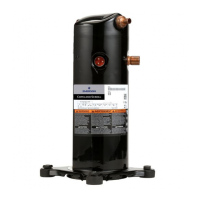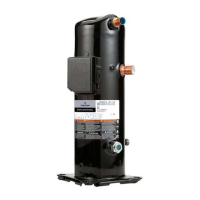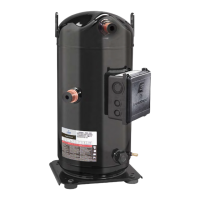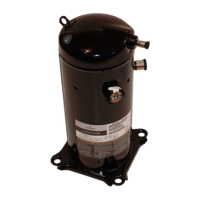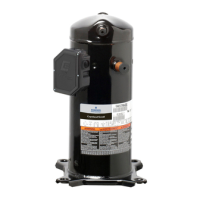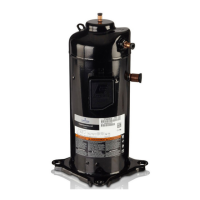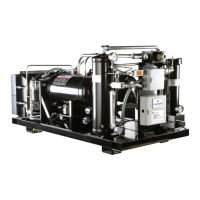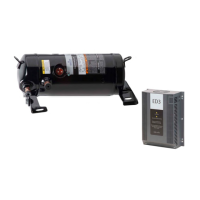6
© 2015 Emerson Climate Technologies, Inc.
AE4-1400 R1
Operating Envelope
The ZP*K6 compressor family is approved for use with
R-410A only. See Figure 1 for the R-410A operating
envelope. The envelope represents acceptable operating
conditions with 20F° (11K) superheat in the return gas.
Power Supply
All motors for the ZP compressors, whether single
or three phase, with the exception of the “PFV” 208-
230, 1Ø, 60 Hz motor, are designed to operate within
a voltage range of +/-10% of the voltages shown
on the nameplate. For example, a compressor with
a nameplate voltage of 200-230 volts can start and
operate within a range of 180-253 volts. Compressors
with a “PFV” designated motor such as ZP24K6E-PFV,
may only be operated in a range of 197-253 volts under
maximum load conditions.
Accumulators
The use of accumulators is very dependent on the
application. The Copeland Scroll compressor’s inherent
ability to handle liquid refrigerant during occasional
operating ood back situations make the use of an
accumulator unnecessary in standard designs such
as condensing units. Applications such as heat pumps
withoricerefrigerantcontrolthatallowlargevolumes
ofliquidrefrigeranttoood backto thecompressor
during normal steady operation can dilute the oil
to such an extent that bearings are inadequately
lubricated, and wear will occur. In such a case an
accumulatormustbeusedtoreduceoodbacktoa
safe level that the compressor can handle. Heat pumps
designed with a TXV to control refrigerant during
heating may not require an accumulator if testing
assures the system designer that there will be no
oodbackthroughouttheoperatingrange.Totestfor
oodbackconditionsanddetermineiftheaccumulator
or TXV design is adequate, please see the section
entitled Application Tests. The accumulator oil
return orice should be from .040 to .055 inches
(1 – 1.4mm) in diameter depending on compressor
sizeandcompressoroodbackresults.Alarge-area
protectivescreennonerthan30x30mesh(0.6mm
openings)isrequiredtoprotectthissmalloricefrom
plugging. Tests have shown that a small screen with
anemesh caneasilybecomepluggedcausing oil
starvation to the compressor bearings. The size of
the accumulator depends upon the operating range
of the system and the amount of sub cooling and
subsequent head pressure allowed by the refrigerant
control. System modeling indicates that heat pumps
that operate down to and below 0°F (-18°C) will require
an accumulator that can hold around 70% to 75% of
the system charge. Behavior of the accumulator and
its ability to prevent liquid slugging and subsequent oil
pump-out at the beginning and end of the defrost cycle
should be assessed during system development. This
will require special accumulators and compressors
with sight tubes and/or sight glasses for monitoring
refrigerant and oil levels.
Screens
Screens ner than 30x30 mesh (0.6mm openings)
should not be used anywhere in the system with these
compressors. Field experience has shown that ner
mesh screens used to protect thermal expansion
valves, capillary tubes, or accumulators can become
temporarily or permanently plugged with normal system
debrisandblocktheowofeitheroilorrefrigeranttothe
compressor. Such blockage can result in compressor
failure.
Crankcase Heat - Single Phase
Crankcase heater recommendations/requirements for
single phase compressors are as follows:
A heater is recommended if:
compressor charge limit < system charge < system charge limit
A heater is required if:
compressor charge limit < system charge > system charge limit
Please refer to Table 4 for a complete listing of
compressor and system charge limit values.
Experiencehasshownthatcompressorsmayllwith
liquid refrigerant under certain circumstances and
system congurations, notably after long off cycles
when the compressor has cooled. This may cause
excessive start-up clearing noise; or the compressor
may start and trip the internal overload protector several
times before running. The addition of a crankcase
heater will reduce customer noise and dimming light
complaints since the compressor will no longer have
to clear out liquid during starting. Table 5 lists the
crankcase heaters recommended for the various
models and voltages. WARNING! Crankcase heaters
must be properly grounded. To properly install the
crankcase heater, the heater should be installed as low
on the compressor shell as possible, either above or
below the lower bearing pin welds that protrude from
the compressor shell. Ideally the heater would come
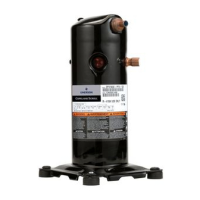
